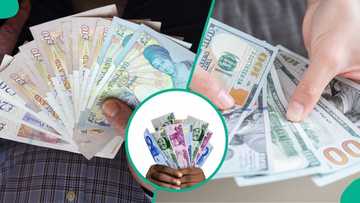Naira Under Pressure? Dollar Inflow into NFEM Falls to $3.2 Billion amid External Reserves Gain
- The Nigerian naira may be in danger of depreciation as dollar inflows into the foreign exchange market drop
- Data shows that dollar inflows into the Nigerian Foreign Exchange Market (NFEM) fell by 5.7% in September to $3.18bn from $3.37bn the previous month
- Experts explained that foreign investment in the equities and bonds markets remained strong
Pascal Oparada, a reporter for Legit.ng, has over ten years of experience covering technology, energy, stocks, investment, and the economy.
The Nigerian currency is walking a tightrope once again as US dollar inflows into the Nigerian Foreign Exchange Market (NFEM) fell by 5.7% in September to $3.18 billion, down from $3.37 billion in August.
Data cited by Cordros Capital Limited revealed that while foreign investments into equities and bonds remained strong, the overall decline was driven largely by weaker inflows from local sources.

Source: Getty Images
Local inflows plunge, but foreign investors step in
Despite the slowdown, the naira managed to hold firm, buoyed by steady investor confidence, increased remittances, and interventions from the Central Bank of Nigeria (CBN).
Figures from FMDQ showed a significant drop in local inflows. down 32.4% month-on-month to $1.42 billion, compared to $2.10 billion in August.
This was caused by declines in dollar supplies from the CBN, exporters, and non-bank corporates.
The CBN’s own FX supply fell sharply by 54.4%, while non-bank corporate inflows dropped by 48.4%.
This means fewer dollars are entering Nigeria’s economy from local players
Exporters contributed 3.2% less than in the previous month. Interestingly, individual inflows nearly doubled, surging 97.3%, reflecting stronger participation from diaspora remittances and personal transfers.
In contrast, foreign inflows rose 38.9% to $1.75 billion, up from $1.26 billion in August.
The gains came mainly from Foreign Direct Investments (FDIs) and Foreign Portfolio Investors (FPIs), which increased by 12.2 and 22.3 percentage points, respectively.
Cordros analysts noted that “the 25.4% growth in fixed income and equity investments helped offset losses from other corporate sources,” highlighting that offshore investors are still finding Nigeria’s markets attractive amid high yields and improved policy transparency.

Read also
Nigeria’s billionaire shake-up: Abdul Samad Rabiu dethrones Adenuga as Dangote soars toward $30bn
CBN measures and market rebound
The naira traded within the ₦1,531–₦1,522 per dollar range in September, supported by improved liquidity and a $150 million CBN intervention.
The apex bank also introduced a 75% cash reserve ratio (CRR) on non-TSA deposits to tighten naira liquidity and curb excess demand pressures.
As a result, the naira appreciated by ₦44.57 or 2.91% month-on-month, closing stronger than August’s ₦1,531.57 per dollar.
Nigeria’s external reserves rose by $1.08 billion to $42.35 billion, offering a firmer cushion for FX stability.
Credit tightens as banks turn cautious
Meanwhile, credit to the private sector fell by 2.17% (₦1.69 trillion) to ₦76.14 trillion in June, reflecting banks’ cautious stance amid high interest rates and tight monetary policy.
However, Nigeria’s broad money supply (M3) climbed to ₦117.50 trillion, a 3.65% increase, supported by a 27.47% rise in net foreign assets.
Analysts expect the near-term outlook to remain positive, predicting FX inflows “to surpass 2024 levels” as investor confidence deepens and carry-trade opportunities persist.
However, analysts believe the naira remains on a solid footing due to Nigeria’s robust reserves, driven by oil earnings.
“For now, now need to panic because the reserves are strong enough to support months of imports and FX withdrawals,” Osas Igho, a financial analyst, said.

Source: Getty Images
According to him, there are predictions about the naira ending the year stronger at N1,400 per dollar.
Naira rally narrows FX gap to just N10
Legit.ng earlier reported that the disparity between the official and parallel markets drifted further, as the naira maintained its gains in all FX markets.
The naira exchange rate gap fell sharply as the local currency surged against the dollar.
The dollar rate declined on Tuesday, September 9, 2025, as the market expected the US Federal Reserve to reduce rates after a disappointing job report.
Don't miss out! Join Legit.ng's Sports News channel on WhatsApp now!
Source: Legit.ng




